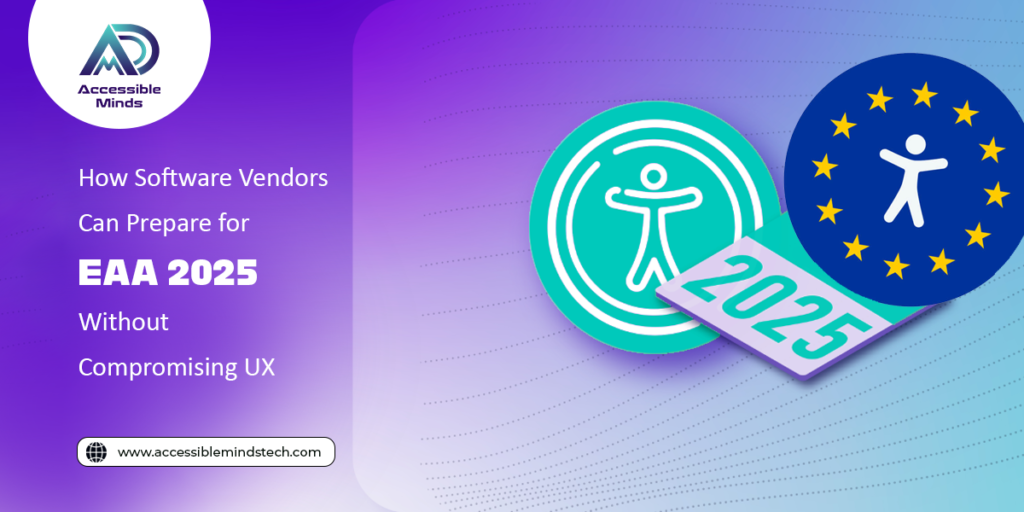The clock is ticking for software vendors across the European Union. With the European Accessibility Act (EAA) enforcement deadline set for June 28, 2025, vendors must ensure that their digital products—websites, mobile apps, eBooks, self-service kiosks, and more—are accessible to all users, including people with disabilities. But there’s a catch: accessibility requirements often raise concerns about degraded user experience (UX).
So how can vendors comply with the EAA without compromising on UX quality? Let’s dive in.
Understanding EAA Compliance: What’s Required?
The EAA was adopted to harmonize accessibility requirements across the EU and promote inclusive digital environments. For software vendors, this means ensuring that users with visual, auditory, cognitive, and motor disabilities can effectively use their digital products.
To meet EAA standards, vendors must align with the EN 301 549 specification—Europe’s official accessibility framework, which closely mirrors WCAG 2.1/2.2 (Web Content Accessibility Guidelines). Non-compliance can result in financial penalties of up to 4% of annual turnover and serious reputational damage.
The UX Dilemma in Accessibility
A common misconception is that making a digital platform accessible means cluttered interfaces, complex navigation, or stripped-down features. In reality, good accessibility enhances UX—for everyone. However, to strike the right balance, accessibility must be baked into the design and development process—not retrofitted later.
That’s where Digital Accessibility Testing Services come in.
1. Shift Accessibility Left in the SDLC
To prepare for EAA 2025 without compromising UX, vendors must embed accessibility from the start of the Software Development Life Cycle (SDLC). This “shift-left” approach ensures accessibility is considered during:
- Requirement gathering
- Design prototyping
- Front-end development
- QA and regression testing
By involving accessibility testers and assistive technology users early, vendors avoid costly reworks and user experience trade-offs.
2. Adopt Inclusive Design Principles
Inclusive design ensures that products are usable by as many people as possible—regardless of ability. This doesn’t mean designing for the lowest common denominator; it means creating flexible experiences.
Key inclusive design strategies include:
- Providing text alternatives for non-text content
- Ensuring keyboard navigation for all interactive components
- Using clear visual hierarchy and sufficient contrast
- Allowing users to adjust font size or layout
- Supporting screen readers and voice commands
Tools like Figma’s accessibility plugins, Adobe XD accessibility checks, and ARIA (Accessible Rich Internet Applications) help designers visualize and implement these principles without sacrificing aesthetics or usability.
3. Leverage Digital Accessibility Testing Services
Not all accessibility barriers are obvious. Automated tools can only detect around 30% of issues. That’s where Digital Accessibility Testing Services play a vital role in identifying gaps that impact real users.
These services include:
- Manual accessibility audits using assistive tech (e.g., screen readers like NVDA, VoiceOver)
- Code-level analysis for ARIA roles, semantic HTML, and labeling
- User journey testing with people who have disabilities
- Compliance mapping against EN 301 549 and WCAG guidelines
- Remediation guidance to ensure fixes don’t disrupt core UX elements
Choosing the right accessibility testing partner ensures that software vendors stay on track toward EAA compliance—without unnecessary design compromises.
4. Create Accessibility Regression Frameworks
Accessibility is not a one-time task—it must evolve with the product. Vendors should establish automated regression testing frameworks that incorporate accessibility checks during every release.
Tools like:
- axe DevTools,
- Pa11y,
- Lighthouse,
- and Tenon
can be integrated into CI/CD pipelines for ongoing compliance assurance.
These tools validate that new features or UI changes do not break existing accessibility—and by extension, UX.
5. Engage End Users in Usability Testing
User testing is essential for ensuring that accessibility enhancements improve, not hinder, usability. Software vendors should include people with disabilities in beta testing groups and focus studies. This helps answer questions like:
- Is the screen reader navigation intuitive?
- Are error messages descriptive and helpful?
- Can users with motor impairments complete critical tasks easily?
Feedback from real users provides insights no automated tool can match, and ensures the final product is usable, intuitive, and inclusive.
6. Educate Your Team and Build Accessibility Champions
Preparing for EAA 2025 is a team effort. From product owners and designers to developers and QA testers—everyone should understand accessibility best practices and the business impact of non-compliance.
Conduct:
- Regular training sessions on WCAG and EN 301 549
- Workshops on using assistive technologies
- Accessibility hackathons to build awareness
Having internal champions who advocate for accessibility can make a big difference in maintaining quality UX standards while staying legally compliant.
Final Thoughts
With the 2025 deadline approaching, accessibility is no longer optional—it’s essential. But contrary to popular belief, accessible products don’t have to come at the cost of great UX. With early planning, inclusive design, expert testing, and user feedback, software vendors can achieve both.
Investing in Digital Accessibility Testing Services not only ensures compliance with the European Accessibility Act but also expands your user base, improves SEO, and builds a brand centered on inclusion and innovation.

